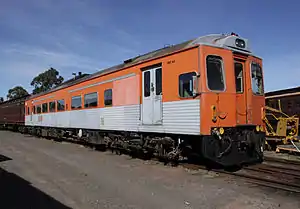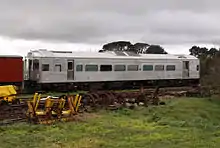DRC railcar
The DRC (Diesel Rail Car) was a class of railmotor operated by the Victorian Railways on its country rail network in Victoria, Australia. The cars were built by Tulloch Limited in New South Wales, and featured aluminium and steel construction, air-conditioning, and twin diesel engines with hydraulic transmissions.
| DRC Railcar | |
|---|---|
 DRC43 at Seymour Railway Heritage Centre in March 2010 | |
| In service | 1971-1995 |
| Manufacturer | Tulloch Limited |
| Built at | Rhodes |
| Constructed | 1971-1973 |
| Entered service | 1971 |
| Number built | 4 |
| Number scrapped | 0 |
| Fleet numbers | DRC40-DRC43 |
| Operator(s) | Victorian Railways V/Line |
| Specifications | |
| Car length | 23.47 metres |
| Width | 2.88 metres |
| Height | 4.18 metres |
| Maximum speed | 112 km/h |
| Weight | 65 t (64.0 long tons; 71.7 short tons) |
| Traction system | Diesel |
| Prime mover(s) | Cummins NTA 855-R |
| Transmission | Voith T113 2 stage automatic hydraulic transmission, Dana-Spicer axle drive to one axle per bogie |
| Track gauge | 1,600 mm (5 ft 3 in) |
History
The first railcars of this type were built in 1970 for the New South Wales Government Railways as 1200 class railcars.[1] The Victorian Railways decided to order two railcars of the same design, to replace the 280hp Walker railmotors then in use.[2] The first DRC entered service in May 1971, classified DRC40, followed by DRC41 on November 1971.[3]
The NSW fleet suffered numerous failures in service,[4] and by 1974 the NSW Public Transport Commission had decided to withdraw the cars from service.[2] Eight of them were converted to loco-hauled carriages in 1982, and used on the South Coast Daylight Express until January 1991, and on Moss Vale and Goulburn services until November 1993.[5][6]
In 1974, the Victorian Railways purchased two of the withdrawn NSW 1200-class cars and modified them for Victorian use. They entered service as DRC42 (formerly PCH 1224) and DRC43 (formerly PCH 1227) in August and December 1975 respectively.[4] Problems with reliability had emerged by the late 1970s, and a modification program was carried out at the Bendigo Workshops in 1983 and 1984.[7] In 1974, four Harris suburban carriages were converted to MTH carriages for use as trailers with the DRC railcars.[8]
In the 1980s, the DRC railcars were the fastest train in Australia by average speed, running the 107 kilometres from Ararat to Hamilton on Mondays and Saturdays in 72 minutes, an average of 89 km/h.[9] The railcars were regularly used on the Stony Point service after 1984, following the reintroduction of passenger services on that line,[10] but by the early 1990s, regular failures saw them replaced by locomotive-hauled trains.
The DRCs were also used on the Leongatha line for a few years, after the line was reopened in 1984, but were replaced by a locomotive-hauled train towing three MTH carriages.[11] The reliability problem was later solved, but the fleet was withdrawn in June 1995, as a result of the introduction of the Goninan-built Sprinter railcars.[2]
Technical details
The features of the DRC railcar.[12] From the No.1 End:
- Driver's cab
- Male and female toilets
- Exit doors
- Second-class compartment: 28 rotating seats, 8 fixed seats - 4 at each end,
- First-class compartment: 20 rotating and reclining seats
No.2 end:
- Exit doors
- Luggage and guard's compartment
- Driver's cab
Today
DRC40 is preserved and operational at the Daylesford Spa Country Railway,[2] and DRC43 is stored in a deactivated condition at the Seymour Railway Heritage Centre.[13][14][15] DRC 41 and 42 are privately owned and stored at Newport Workshops.[16]
Model Railways
HO Scale
In 2013, Trainbuilder released a series of DRC railmotors for $1,195 each. The group included DRC40-43 in original unpainted aluminium, DRC's 40, 41 and 42 in V/Line and DRC 43 in VicRail. At the same time, small quantities of New South Wales PCH railmotors 1221, 1224 and 1227 were released.[17]
Gallery
 DRC40 in bare silver livery at the Daylesford Spa Country Railway
DRC40 in bare silver livery at the Daylesford Spa Country Railway DRC41 and DRC42 stored at Newport Workshops
DRC41 and DRC42 stored at Newport Workshops The first-class seating compartment in DRC43
The first-class seating compartment in DRC43 The second-class seating compartment in DRC43
The second-class seating compartment in DRC43 The conductor's seat at the No.2 end of DRC43
The conductor's seat at the No.2 end of DRC43 The driver's cab at the No.2 end of DRC43
The driver's cab at the No.2 end of DRC43 Close-up of No.2 end controls of DRC43
Close-up of No.2 end controls of DRC43
References
- Cooke, David (1984). Railmotors and XPTs. Australian Railway Historical Society NSW Division. ISBN 0-909650-23-3.
- "Daylesford Spa Country Railway: DRC40". Archived from the original on 30 August 2007. Retrieved 10 November 2007.
- Peter J Vincent: DRC - Tulloch Diesel Rail Car
- "VictorianRailways.net - DRC railmotors". Archived from the original on 4 December 2007. Retrieved 10 November 2007.
- "South Coast timetable" Railway Digest April 1991 page 114
- "Loco-Hauled Car Changes" Railway Digest February 1994 page 36
- VictorianRailways.net - DRC diagram
- MTH Carriages V/LineCars.com
- Railpage Australia: What lines did the DRCs run on?
- "The Stony Point passenger service reopened". Newsrail. Australian Railway Historical Society (Victorian Division). October 1984. p. 309.
- "News". Newsrail. Australian Railway Historical Society (Victorian Division). March 1990. p. 89.
- DRC diagram
- "Seymour Railway Heritage Centre - Railfans - Locomotives Register". Archived from the original on 20 July 2008. Retrieved 10 November 2007.
- Martin Bennett: SRHC depot - General
- "Evan Cottle: DRC43 at SRHC". Archived from the original on 2 May 2008. Retrieved 10 November 2007.
- Railpage Australia: DRC's
- http://trainbuilder.com/drc